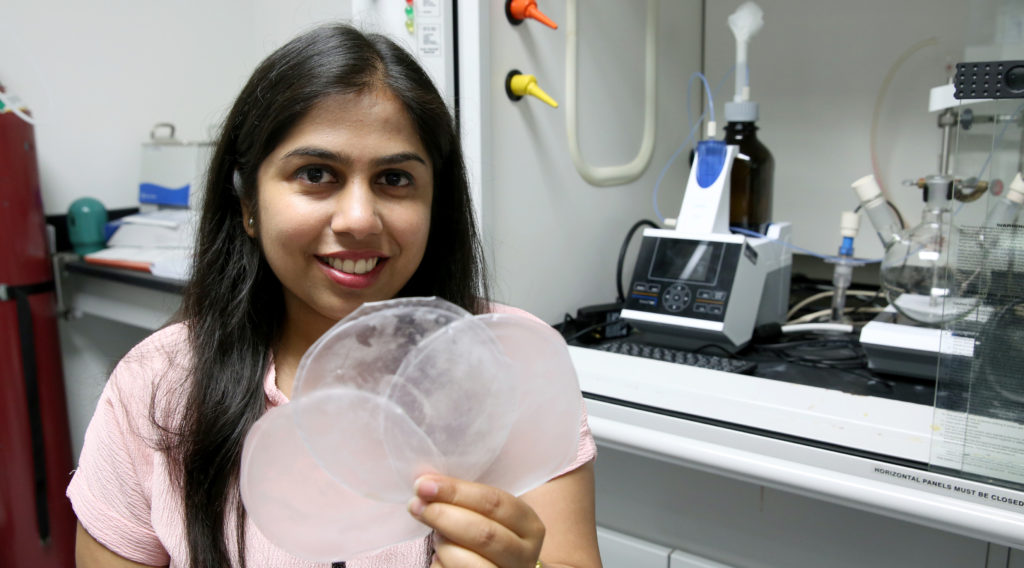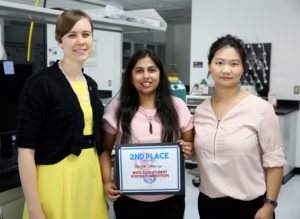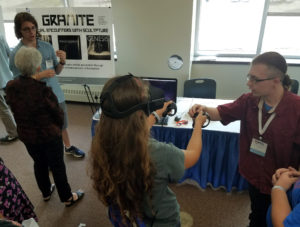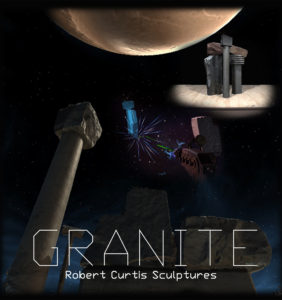
UW-Stout graduate student Pratigya Thapaliya presented research at the WiSys innovation symposium on creating antimicrobial packaging for cheese.
Menomonie, Wis. — Two projects with very different research goals — one to inhibit mold growth on packaged cheese and the other to create a virtual reality experience with art — have brought state recognition to University of Wisconsin-Stout students.

UW-Stout student Pratigya Thapaliya, center, receives a WiSys innovation symposium certificate from Kristen Ruka, left, WiSys regional associate. At right is project director Assistant Professor Min DeGruson.
At the WiSys annual innovation symposium, WSTS, held in July at UW-Platteville, graduate student Pratigya Thapaliya, of Nepal, took second place in the poster division. She presented research on how to make antimicrobial packaging for cheese to prolong product shelf life while reducing preservatives in the food.
A team of undergraduate students also took a second place, in the innovation showcase. They created interactive virtual reality experiences based on four sculptures that stand outside of the Memorial Student Center on campus.
WiSys’ symposium drew 117 university students and a record 257 attendees in its 10th year. WiSys, www.wisys.org, is an independent, nonprofit organization that serves as the technology transfer office for the UW System, supporting the creation and transfer of innovations from the University of Wisconsin System to the marketplace.
Food packaging engineering research
Thapaliya, pursuing a master’s in food and nutritional sciences, conducted her research with Assistant Professor Min DeGruson, packaging undergraduate program. A WiSys research grant was awarded to DeGruson in 2016 to develop the project.
Making the antimicrobial packaging was a multistep process. One aspect involved creating a chemical reaction to load antimicrobial agents into nanoparticles. The modified nanoparticles, in powder form, then were dissolved in water at a high temperature with corn starch to make the biodegradable film.
“We worked very hard to perform these tests, almost every day for two to three months, to optimize the process,” Thapaliya said.
Thapaliya and DeGruson tested the finished product and it worked as hoped — inhibiting mold growth when covering cheese. More tests must be done to optimize the process further, but their work offers promise to improve packaging for cheese, meat and other foods.
DeGruson, who also is working with graduate student Disha Trivedi, estimates that the film is about four one-thousandths of an inch thick but has more than 10,000 layers of nanoparticles.

UW-Stout students Austin Lewer, left, and Daniel Johnson explain the Granite virtual reality project at the WiSys innovation symposium held in July at UW-Platteville.
Some of the project testing, such as to verify modification of nanoparticles, was conducted at the materials science center at UW-Eau Claire. “It’s a great example of campus interconnectivity,” said Kristen Ruka, a regional associate for WiSys.
DeGruson said UW-Eau Claire “spent hours to train us how to use their equipment,” and she and the students have used at least five labs at UW-Stout — food science, chemistry, packaging, plastics, and materials science/nanotechnology.
Virtual reality art experience
Since 1987, four granite block-and-pillar sculptures by Milwaukee artist Robert Curtis have stood outside the student center. The UW-Stout students created digital 3D models of them using photogrammetry software, which generates 3D models from photos.
The 13 students then developed virtual reality experiences in a project called Granite: Virtual Encounters with Sculpture. The goal was to create “a novel experience with art by curating the sculptures in unconventional and interactive ways,” said Associate Professor Mitch Ogden, who oversaw the project.
Three student teams created three virtual reality experiences for use with Oculus Rift. Attendees at the symposium in Platteville could try a demo with an Oculus Rift headset.

The Granite virtual reality experience is based on sculptures, created 30 years ago, that stand outside UW-Stout’s Memorial Student Center.
One of the experiences involves seeing a sculpture disassembled on the Harvey Hall Theatre stage and having the chance to put it back together. Another experience provides the opportunity to blast one of the sculpture’s blocks with a laser gun in zero gravity; a hit dissolves into information about the history of the sculpture.
Representing the team at the WSTS event were students Austin Lewer, of Marshfield, and Daniel Johnson, of Park Falls. Lewer is majoring in game design and development-art and was the team’s virtual reality consultant and developer. Johnson is majoring in professional communication and emerging media.
Johnson and the 11 other team members were enrolled in a digital humanities seminar course during the spring semester.
